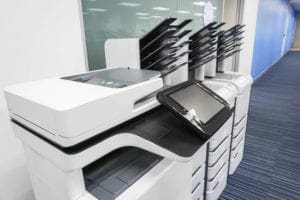
Top Commercial Copier Features in 2023
As technology continues to evolve, commercial copiers have become more than just a device for duplicating documents. They now offer a plethora of features that streamline operations, improve productivity, and contribute to better data management in the workplace. In 2023, these high-tech copiers have become an essential part of successful business operations. This blog will explore the top commercial copier features in 2023 that you need to look out for.
COMPARE QUOTESWireless and Mobile Printing
One of the most sought-after features in modern commercial copiers is wireless and mobile printing. With the increase in remote work and the growing need for on-the-go solutions, having the ability to print documents from mobile devices is crucial. It allows employees to print directly from their smartphones or tablets, regardless of their location in the office, enhancing convenience and efficiency.
Advanced Security Features
Data security continues to be a top priority for businesses in 2023. As copiers have become digital and connected to networks, they are potential entry points for data breaches. Advanced security features, such as data encryption, user authentication, and intrusion detection, are critical for protecting sensitive information. Some copiers also offer the option to overwrite the hard drive, ensuring that no traces of your copied data are left behind.
Multi-Function Capabilities
Commercial copiers in 2023 have transcended their traditional roles and become multi-function devices. They integrate copying, printing, scanning, and faxing into one machine, saving space and cost. They also enhance productivity by eliminating the need to move between different devices to perform various tasks.
Environmentally Friendly Features
As businesses become more eco-conscious, the demand for green features in commercial copiers has increased. These include energy-saving modes that conserve electricity when the copier is not in use, duplex printing to reduce paper usage, and the use of eco-friendly toners.
Cloud Connectivity
Cloud connectivity has become a must-have feature in 2023’s commercial copiers. It allows users to directly access and print documents from cloud-based platforms such as Google Drive or Dropbox. It also enables scanning documents directly to the cloud, which aids in efficient document management and remote access.
High-Resolution Printing
The quality of output is crucial in a commercial copier. High-resolution printing ensures that your documents, especially those with graphics, are clear, crisp, and professional-looking. The standard resolution in 2023 is around 1200 x 1200 dots per inch (dpi), which provides excellent quality for most businesses.

User-Friendly Interface
A user-friendly interface is key for efficient operation. Touchscreen interfaces have become standard in most commercial copiers in 2023, offering intuitive navigation and easy access to all functions. Some advanced models even offer customization options to suit the specific needs of your business.
Automatic Updates
With rapid advancements in technology, having a copier that automatically updates its software ensures that your device stays current with the latest features and security enhancements. It also reduces the need for manual updates and maintenance, saving time and resources.
In 2023, commercial copiers have taken a central role in streamlining operations and improving productivity in the workplace. From advanced security features to cloud connectivity, the top features discussed above are transforming how businesses handle document management. As you plan to invest in a commercial copier, ensure that you consider these features to get the most out of your investment.
COMPARE QUOTESCommercial Copiers vs. Home Copy Machines: Understanding the Difference
While commercial copiers and home copy machines both perform the fundamental task of making duplicates of documents, they are designed to serve different environments and vary significantly in terms of functionality, durability, capacity, and cost. Let’s break down some key differences:
1. Volume and Speed:
Commercial copiers are designed to handle a higher volume of printing and copying jobs compared to home copy machines. They can process thousands of pages per day and offer faster printing and copying speeds, making them an ideal choice for businesses with high printing needs.
2. Durability and Lifespan:
Commercial copiers are built to last. They are designed for heavy use and tend to have a longer lifespan than home copy machines. The parts and components of commercial copiers are more robust, leading to fewer breakdowns and maintenance needs.
3. Multi-Functionality:
While home copy machines usually offer basic copying and sometimes scanning capabilities, commercial copiers often come with multi-function features. As mentioned earlier, they can print, scan, copy, and fax documents, providing an all-in-one solution for businesses.
4. Advanced Features:
Commercial copiers come equipped with advanced features not usually found in home copy machines. This includes network connectivity, wireless and mobile printing, high-resolution printing, automatic duplexing, and advanced security features.
5. Cost:
Due to their enhanced functionality, durability, and capacity, commercial copiers are typically more expensive than home copy machines. However, considering their benefits and the potential for cost savings in the long run (through improved productivity and reduced downtime), they are often a worthwhile investment for businesses.
6. Size:
Commercial copiers tend to be larger than home copy machines due to their expanded functionality and higher capacity. While a home copy machine can fit comfortably in a small home office, a commercial copier may require a dedicated space in a business setting.



While home copy machines may suffice for individual or small-scale copying needs, commercial copiers are designed to meet the demands of a business environment. When choosing between the two, consider factors such as your daily volume of copying and printing, the need for additional functionalities, and your budget.
COMPARE QUOTESVital Commercial Copier Features for Small Businesses
As technology advances, commercial copiers are becoming more sophisticated, offering features designed to improve efficiency and productivity. Here are some of the top features you should look for in a commercial copier for your small business:
- Mobile Device Compatibility: This allows users to print or scan documents directly from their mobile devices. This feature enhances convenience, especially for businesses that encourage remote or flexible working arrangements.
- Multifunction Printer: A multifunction copier combines several office machines into one. It can print, copy, scan, and sometimes fax documents, saving space and potentially reducing overhead costs.
- Color Copiers: Color copiers can reproduce documents in full color, making them ideal for businesses that need to produce high-quality, professional-looking documents, presentations, or marketing materials.
- Automatic Document Feeder: An automatic document feeder can take multiple pages and feed them one page at a time into a scanner or copier, allowing for unattended copying or scanning jobs. This feature is particularly useful for businesses that regularly need to scan or copy multi-page documents.
- High Print Speed: Commercial copiers with high print speeds can process jobs quickly, helping businesses operate more efficiently. This is crucial for businesses that frequently need to print or copy large documents.
- Toner Cartridges: Some commercial copiers use high-capacity toner cartridges, which can yield a higher number of pages and need to be replaced less frequently. This can reduce the copier’s downtime and lower the overall printing costs.
- Best Copier Brands: When investing in a commercial copier, consider choosing from the best copier brands that have a reputation for quality, durability, and excellent customer service. These brands often offer comprehensive warranties and reliable customer support, which can give you peace of mind.
Each of these features brings unique benefits, and the right mix will depend on your business’s specific needs and budget. Ensure to consider each of these aspects when deciding on the best copier for your small business in 2023.
COMPARE QUOTESIn-Depth Review of Top Commercial Copiers in 2023
The rapid pace of technology advances keeps reshaping the landscape of commercial copiers, bringing us multifunction devices that are more efficient, reliable, and versatile than ever before. Let’s dive into the details of some of the top-rated commercial copiers on the market in 2023.
Canon ImageRunner Advance DX C357iF: Advanced Multifunctionality at Its Finest
Canon’s ImageRunner Advance DX C357iF stands out in the market for its multifunction capabilities. This powerhouse doesn’t only handle copying and printing; it also covers scanning, emailing, and even faxing tasks. With a high-speed functionality capable of producing up to 60 pages per minute, it’s a perfect choice for businesses that deal with large volumes of printing.



What sets the Canon ImageRunner apart is its user-friendly interface, courtesy of a responsive touchscreen, and robust security features. It offers data encryption and user authentication, ensuring that your sensitive business information remains protected. Despite all its features and capabilities, this model stands out for its energy efficiency, making it an eco-friendly option for businesses.
HP LaserJet Pro MFP M428fdw: The Compact Powerhouse
If you’re operating a small business where high-quality prints are a must, but space is at a premium, the HP LaserJet Pro MFP M428fdw might be just what you need. Its compact design hides powerful capabilities. With a printing speed of up to 30 pages per minute, this model guarantees fast output without taking up much space.
One of the standout features of the HP LaserJet Pro is its wireless printing capability. You can print directly from your mobile device or computer, eliminating the need for extra wires and providing added convenience. With its competitive pricing, this compact powerhouse offers excellent value for small to medium-sized businesses.
Xerox VersaLink C405: Color Printing with Incredible Precision
Color printing is a significant concern for many businesses, especially those in creative industries that rely on high-quality color prints for their operations. In this regard, the Xerox VersaLink C405 shines. It delivers sharp, vibrant color prints, thanks to its high-resolution printing capabilities.
What makes the Xerox VersaLink C405 a popular choice among businesses is its intelligent design and intuitive touchscreen interface that offers customizable apps for different tasks. Plus, it comes with robust security features, including Secure Print and card authentication to control access.
Brother MFC-L8900CDW: Designed for High Volume Tasks
The Brother MFC-L8900CDW is a great choice for businesses requiring high-volume printing. This commercial copier provides efficient, fast printing – up to 33 pages per minute. It has a 70-page capacity auto document feeder for professional two-sided copying, scanning, and faxing.
In addition, the Brother MFC-L8900CDW features a 5-inch color touchscreen that allows easy menu navigation and the creation of up to 64 customized shortcuts. Its advanced security features include an integrated NFC card reader, which allows for easy badge authentication.
Sharp MX-3071: Advanced Usability for Maximum Efficiency
With the Sharp MX-3071, advanced usability and stunning color output go hand in hand. This multifunction copier offers high-quality printing with a resolution of up to 1200 x 1200 dpi. It also includes a walk-up motion sensor that brings the machine to ready condition within 10 seconds.
COMPARE QUOTESThe Sharp MX-3071 shines when it comes to usability, offering a customizable touchscreen interface that can be tailored to individual users’ needs. With advanced finishing options, wireless connectivity, and robust security, this commercial copier is well-equipped to handle the most demanding business environments.
By familiarizing yourself with the top commercial copiers available in 2023, you’ll be well-prepared to choose a device that suits your business’s unique needs.




Maintenance and Troubleshooting of Commercial Copiers
Just like any other piece of equipment, commercial copiers need regular maintenance to function at their best. This not only ensures consistent performance but also extends the machine’s lifespan, reducing the total cost of ownership.
Regular Maintenance
Regular maintenance involves:
- Cleaning: Dust and debris can accumulate in a copier, causing paper jams and streaks on the output. Regular cleaning of the internal components is necessary to maintain quality.
- Inspection: Regular inspection can help detect issues early before they cause significant damage. Check for worn-out parts and replace them as necessary.
- Regular servicing: Schedule regular servicing by a professional technician. They can spot issues you might miss and make necessary adjustments to keep the copier in top shape.
- Updating firmware: Like any tech device, keeping the firmware of your copier up-to-date is crucial. New updates often come with bug fixes and performance improvements.
Troubleshooting Common Issues
- Paper Jams: These are the most common copier issue. Most of the time, you can fix this by gently removing the jammed paper. Ensure you use the correct paper type and size as recommended by the manufacturer.
- Poor Print Quality: If you notice streaks, spots, or faded prints, it might be due to dirty or worn-out components. Clean the machine and replace components as necessary. Regular maintenance often prevents this issue.
- Connectivity Issues: If your copier has trouble connecting to the network, check your internet connection. You might also need to update your device’s firmware or drivers.
- Error Codes: Modern copiers display error codes when there’s a problem. While some codes are self-explanatory, others might require you to check the user manual or consult with a professional.
Remember, while basic troubleshooting can solve minor issues, more complex problems should be handled by professionals to prevent further damage. The key to keeping your commercial copier in top shape is a combination of regular maintenance and prompt troubleshooting.
COMPARE QUOTESUnderstanding Copier Specifications
Choosing the right commercial copier involves understanding certain technical specifications. These specifications directly relate to the machine’s performance and its fit for your specific needs. Here are some of the main specs you should consider:
1. Print Speed
Also referred to as pages per minute (PPM), print speed is a critical specification for businesses that need to produce large volumes of documents quickly. Commercial copiers typically have much higher PPM ratings than home office models.
2. Print Resolution
Measured in dots per inch (DPI), print resolution impacts the quality of the documents produced. A higher DPI results in clearer, more detailed prints. For most businesses, a print resolution of 600 x 600 DPI is sufficient, but if your business needs include high-quality photo printing, look for higher DPI ratings.
3. Paper Capacity
This indicates the number of sheets the copier can hold in its tray(s). High-capacity trays are beneficial for businesses that print large volumes regularly, reducing the need for frequent paper refilling.
4. Connectivity Options
Commercial copiers now often feature network and wireless connectivity options. This allows multiple devices to connect to the copier, facilitating easy sharing across devices.



5. Duplexing
A copier with automatic duplexing can print on both sides of the paper without manual intervention, saving paper and making document handling more efficient.
6. Multifunction Features
Many commercial copiers are multifunction devices, meaning they also offer scanning, faxing, and copying capabilities. Check these features and their specifications to ensure they meet your business needs.
7. Toner Yield
This specification indicates the number of pages a toner cartridge is expected to print before needing replacement. Higher toner yield means less frequent cartridge changes, which is particularly beneficial for high-volume printing.
Remember, the right copier for your business depends on your specific needs. Understanding these specifications will allow you to choose a commercial copier that best fits your requirements and budget.
COMPARE QUOTESBuying vs. Leasing Commercial Copiers
When it comes to acquiring a commercial copier, businesses typically have two options: buying or leasing. Each option has its advantages and potential drawbacks, and the choice largely depends on a company’s specific needs and circumstances.
Buying a Commercial Copier
Purchasing a commercial copier outright can be an excellent choice for businesses with a high volume of printing and the budget to cover the initial costs.
Advantages:
- Full Ownership: Once you buy a copier, it’s yours. You’re not bound by any usage limits or terms of a lease agreement.
- No Monthly Payments: After the initial purchase, you’re free from monthly lease payments.
- Potential for Depreciation: In certain situations, you can write off the cost of the copier as a business expense.
Drawbacks:
- High Upfront Cost: Commercial copiers can be expensive, and the cost can range anywhere from $3,000 to over $12,000 depending on the specifications and features.
- Maintenance Responsibility: Owning a copier means you are responsible for all maintenance and repairs.
- Outdated Technology: As technology evolves, you might find your copier becoming outdated without the flexibility to upgrade that a lease can provide.
Leasing a Commercial Copier
Leasing can be a viable option for companies that prefer to spread the cost over a longer period and want the flexibility to upgrade to newer models.
Advantages:
- Lower Initial Costs: Leasing does not require a large upfront investment. Most leases only require the first month’s payment upfront.
- Predictable Expenses: With a lease, you pay a fixed monthly amount, making budgeting easier.
- Easy Upgrades: Leasing allows you to upgrade to newer models at the end of your lease term, ensuring you have access to the latest technology.
Drawbacks:
- Overall Cost: While the initial cost is low, the total cost of leasing can be higher than purchasing over time. Lease rates can vary widely but expect to pay anywhere from $100 to $600 per month, depending on the type and model of the copier.
- Contractual Obligations: Leases come with contractual obligations. You’re committed to making monthly payments for the lease term, which typically lasts several years.
The decision between buying and leasing a commercial copier ultimately depends on your business’s financial situation, printing needs, and preference for flexibility or ownership.



Impact of Advanced Technologies on Copiers
As with most business equipment, the world of commercial copiers is not immune to the influences of advanced technology. Innovations in Artificial Intelligence (AI), the Internet of Things (IoT), and cloud computing are transforming the capabilities of commercial copiers, making them smarter and more efficient. Here’s how:
- Artificial Intelligence (AI):
AI has a significant role to play in improving the functionality of commercial copiers. With AI, copiers can predict and diagnose issues before they occur, minimizing downtime. They can also learn usage patterns to optimize energy consumption and even automatically order supplies when running low.
- Internet of Things (IoT):
IoT technology enables copiers to connect to the internet, transforming them into smart devices. This means they can be managed remotely, enabling real-time tracking and monitoring of copier activities, usage, and even predictive maintenance.
- Cloud Computing:
Cloud connectivity in commercial copiers has become an invaluable feature. It allows for seamless integration with cloud storage platforms, facilitating document sharing and collaboration. Users can print directly from or scan to cloud-based apps, improving workflow efficiency.
The integration of these advanced technologies into commercial copiers is making these devices smarter and more connected. For businesses, this translates into improved efficiency, reduced operational costs, and enhanced workflow. As technology continues to evolve, we can only expect commercial copiers to become even more intelligent and versatile, offering a wealth of possibilities for businesses to optimize their document management processes.
COMPARE QUOTESSecurity Features of Modern Copiers
In today’s digital age, data security is a top priority for businesses. Commercial copiers are not exempt from this concern, as they often handle sensitive and confidential information. Modern copiers come equipped with advanced security features to safeguard data and protect against potential threats. Here are some key security features to look for:
1. Secure Print Release: This feature allows users to securely release their print jobs only when they are physically present at the copier. It prevents unauthorized individuals from accessing sensitive documents left unattended on the output tray.
2. Data Encryption: Commercial copiers now offer data encryption capabilities to protect confidential information during transmission and storage. Encryption ensures that data is unreadable to unauthorized users, safeguarding it from interception or unauthorized access.
3. User Authentication: User authentication features require users to enter a unique identification code or swipe an access card before accessing the copier’s functionalities. This helps ensure that only authorized individuals can use the device, preventing unauthorized use and protecting sensitive information.
4. Data Overwrite and Erase: Many modern copiers have built-in features that allow for secure data erasure. This ensures that any traces of sensitive data are completely removed from the copier’s hard drive after a job is completed, reducing the risk of data leakage.
5. Audit Trails and Reporting: Advanced copiers provide comprehensive audit trails and reporting capabilities. This allows administrators to monitor and track copier usage, including details such as user activity, time stamps, and job history. It enhances accountability and helps detect any suspicious or unauthorized activities.
By investing in a copier with robust security features, businesses can mitigate the risk of data breaches and ensure the confidentiality of their sensitive information. When evaluating copier options, it is crucial to prioritize security features that align with your organization’s specific security requirements and regulatory compliance.




Choosing the Best Office Copier for Your Business
Investing in the right office copier is essential for efficient document management and streamlined business processes. With so many options available, it’s important to consider the specific needs of your business and the features that will best support your operations. Here are some key factors to consider when choosing the best office copier:
- Copying and Printing Speed: Evaluate the copier’s speed in terms of copies per minute (CPM) or pages per minute (PPM). Consider the volume of documents your business handles daily and choose a copier that can keep up with your printing demands.
- Paper Handling and Capacity: Assess the copier’s paper handling capabilities, including paper sizes and types it can accommodate. Consider the input and output tray capacities to ensure the copier meets your requirements without frequent paper reloading.
- Document Feeder: An automatic document feeder (ADF) is a valuable feature that enables efficient scanning and copying of multiple pages. Look for a copier with an ADF that supports duplex (double-sided) scanning for enhanced productivity.
- Print Quality: Check the copier’s print resolution to ensure it delivers high-quality prints and reproduces images and text with clarity. Look for copiers with higher resolution for detailed graphics and professional-quality output.
- Connectivity Options: Consider the connectivity options available with the copier. Look for features such as wireless printing, mobile printing capabilities, and integration with cloud storage services. These features can enhance the convenience and facilitate seamless document sharing.
- Cost Efficiency: Evaluate the copier’s cost per page, including factors like toner cartridge prices and estimated yield. Look for energy-efficient models that can help reduce power consumption and lower operating costs.
- Service and Support: Consider the reputation of the manufacturer and the availability of service and support. Look for warranties, customer support options, and the availability of maintenance services to ensure smooth operation and timely assistance when needed.
- Scalability and Future Needs: Assess your business’s growth projections and consider copiers that can accommodate your evolving needs. Look for models that offer expandable paper trays, additional storage options, and compatibility with software upgrades.
By carefully considering these important features and aligning them with your business processes and requirements, you can choose the best office copier that will enhance productivity, streamline document management, and meet your business’s specific needs. Remember to compare different copier models, read customer reviews, and consult with reputable vendors or service providers to make an informed decision. Investing in the right office copier is a valuable asset that can contribute to the efficiency and success of your business.
COMPARE QUOTES